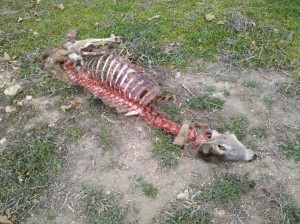Pt. 9: Top 10 Recommendations for Managing Land to Yield Mature, Huntable Deer
Filed under: Deer Management, Hunting Blog, Predator Trapping
Part 9: Predator Induced Stress
Last week I shared with you a summary of Dr. John Kilgo’s long-term research about the amount of fawn mortality primarily caused by coyotes to deer in South Carolina. The results were that 70% of the fawns were killed by predators before the first hunting season after they were born. At that rate of mortality, even without any harvest by hunters, deer populations will decrease. This problem is not everywhere yet. However the number of coyotes, bobcats, black bears, cougars/mountain lions, etc., is increasing rapidly in many areas.
Several of my fellow researchers besides Dr. Kilgo have reported similar findings of predator caused mortality on young deer and even adult deer. Predators are a significant factor on deer populations in many areas!
However, direct mortality is only part of the picture. Even healthy adult deer that are not as susceptible to being killed by predators still can suffer because of high predator populations. Great research on elk in Yellowstone National Park has shown that elk that haven’t been killed by wolves are averaging fewer calves per cow, lower body weights, and the males have smaller antlers on average than before wolves were reintroduced. How can this be? Fewer mouths competing for the same or more food should result in more calves per cow, heavier body weights, and larger antler for each age class.
The answer was found by comparing the levels of specific hormones in elk before they were exposed to wolves and then again five years after wolves had been released into Yellowstone. These hormones are produced and released in critters that are stressed. The levels of these hormones were several times higher in the elk after being exposed to wolves!
This is not surprising. The medical news is full of studies reporting how damaging stress is to human health. Dairy, beef, and even poultry farmers attempt to reduce stress in their stock so they will be more productive. The same is true with game animals. Being chased or even living where they need to be constantly vigilant to avoid predators results in increased stress.
Increases in the number of predator populations (increasing coyote, bobcat, bear, hog, etc.) certainly results in increased stress for several species of game animals.
In addition to reduced health caused by predator induced stress, there is another negative to allowing the predator population to increase significantly.
Deer and turkeys that are constantly vigilant against four-legged predators are also constantly vigilant against two-legged predators. It will likely be more difficult to observe game species on properties that have an abundance of coyotes and other predators. I’ve worked on a few properties that had an abundance of predators. We called and trapped to reduce the number of predators and the observation rate of mature whitetail bucks increased within weeks! These bucks didn’t mature into the population. It is doubtful they moved into the population. They simply became less vigilant.
To have more mature bucks to hunt, there must be more fawns recruited into the population. It’s noticeably easier to have encounters with mature bucks when they are less vigilant. Significantly reducing the number of predators will likely have a positive impact on deer herds. Due to increasing predator populations and decreasing numbers of trappers, predator management is rapidly becoming a significant part of deer and turkey management.
Growing Deer together,
Grant




